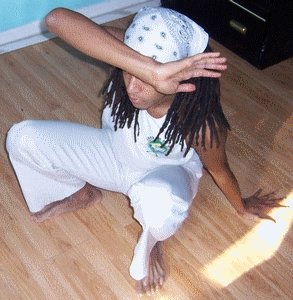|
Capoeira EscapesAfter the basics, the first movements I learned were capoeira escapes or esquivas. I was happy I learned them when I first had to escape kicks to my face! These escapes are essential for playing capoeira. They are a response to attacks and set you up to respond with your own answers. Here are some of the most common (and face saving!) escapes…
Cocorinha (coco-rin-a)
This is the first escape I learned and also one of the simplest. From the ginga base, the player crouches down and uses an arm to protect their face. Even though it seems simple, it’s very useful for dodging kicks.  Resistência (hea-se-stinch-ia)
This literally means ‘resistance’. The player basically falls backward and catches themselves with one arm behind them. This escape is extremely useful for avoiding a kick when you walk into it.  Esquiva Lateral (es-key-va lat-ter-al)
This means a lateral escape. The player leans to one side, placing their weight on that leg and can choose to place their hand on the floor or not. I use it a lot when dodging straight kicks.  Esquiva Baixa (es-key-va bas-che)
The esquiva baixa is a low escape, where the player throws their leg far back from ginga. This brings their body low to the ground, allowing them to dodge high attacks. It sets up for many responses.  Passa Frente (pasa french)
This is a last second escape, where the player steps forward and falls down to a side. The player falls by bending their knees, leaning back and catching themselves. It’s used when stepping into a kick, by falling out of the way without being hit.  Queda de quarto (cada je qua-tro)
In this escape the player falls backwards onto all fours. It’s practiced so you can catch yourself from a takedown or falling out of a movement such as aú.  Queda de tres (cada je tres)
Like the queda de quarto, the player lands backward on two hands and one leg. As with the queda de tres, it’s used to catch yourself. This is especially useful with some takedowns where a leg is swept out, so the player only has one leg and their hands to catch themselves with.  Return from Capoeira Escapes to Capoeira Moves
|


